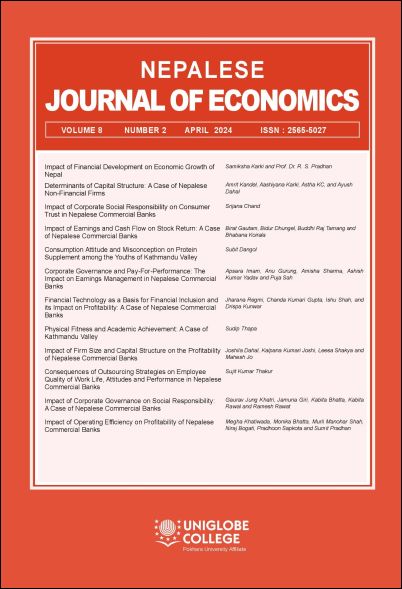Impact of Operating Efficiency on Profitability of Nepalese Commercial Banks
DOI:
https://doi.org/10.3126/nje.v8i2.68812Keywords:
capital adequacy ratio, operating expenses, net interest income, leverage, loan to deposit ratio, return on equity, return on assetsAbstract
The study examines the effect of operating efficiency on the profitability of Nepalese commercial banks. Return on assets and return on equity are selected as the dependent variables. The selected independent variables are capital adequacy ratio, operating expenses, net interest income, leverage, loan to deposit ratio and bank size. The study is based on secondary data of 16 commercial banks with 112 observations for the period from 2015/16 to 2021/22. The data were collected from Banking and Financial Statistics published by Nepal Rastra Bank, publications and websites of Nepal Rastra Bank (NRB) and annual reports of the selected commercial banks. The correlation coefficients and regression models are estimated to test the significance and importance of operating efficiency on the profitability of Nepalese commercial banks.
The study showed that capital adequacy ratio has a positive impact on return on assets and return on equity. It means that increase in capital adequacy ratio leads to increase in return on assets and return on equity. Similarly, operating expenses has a negative impact on return on assets and return on equity. It means that increase in operating expenses leads to decrease in return on assets and return on equity. Further, the study showed that net interest income has a positive impact on return on assets and return on equity. It means that increase in net interest income leads to increase in return on assets and return on equity. Likewise, leverage has a negative impact on return on assets. It means that increase in leverage ratio leads to decrease in return on asset. Furthermore, loan to deposit ratio has a negative impact on return on asset and return on equity. It indicates that increase in loan to deposit ratio leads to decrease in return on asset and return on equity. In addition, bank size has a negative impact on return on assets and return on equity. It shows that larger the bank size, lower would be the return on assets and return on equity.




